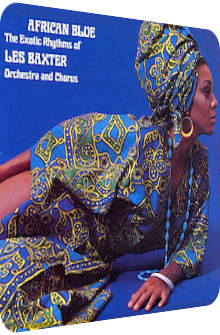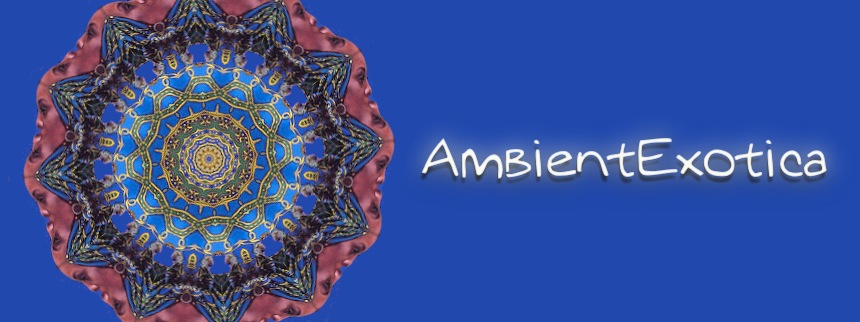
Les Baxter
African Blue
1969
African Blue is a late Exotica entry by visionary composer and regent of Space-Age strings Les Baxter (1922–1996), released in 1969 on the GNP Crescendo label, among others. The version released on the KPM Music label is astonishingly enough also known as Bugaloo In Brazil and sports the same yet differenty titled tracks in order to reflect the Latin locale. Despite its year of release and the dubious location-related mishap – does it sound more African or does it reflect the spirit of Brazil best? – it is probably the exotic artifact that is truly timeless and which cannot be derided as bland Easy Listening.
Featuring the talents of 14 musicians, among them frequent collaborator, saxophonist and flutist Plas Johnson, piano and organ mastermind Douglas Clare Fischer, mallet instrumentalist Larry Bunker as well as guitarists Al Hendrickson and David Cohen, even fleeting visitors in the field of Baxter’s compositions can sense what is so different about this album. African Blue is one of Les Baxter’s, er, specifically special Exotica albums, if only for the fact that he gets rid of the bolstered string cascades, with the only vestigial elements being an acoustic guitar or two, an electric bass pendant and one harp. The timing of this album is equally curious, for a few months later, Les Baxter uses the manpower of 127 instrumentalists on his first 1970 LP Que Mango! which he recorded with the 101 Strings.
In addition, the name Plas Johnson rings a bell and gives another hint, for he is the central force in Les Baxter’s classics African Jazz and Jungle Jazz (both 1959), both of which replaced the cosmic-amicable string ethers he is predominantly known for with a perceptibly dirtier brass sound. African Blue’s rhizomes touch the same alluvial soils, but are otherwise surrounded by an even more enthralling helix of hyper-strong melodies. Here we see an accidental band in top form, joyously worshipping the 12 original pieces of sheet music and transforming them into aural pictures spiced with Latin drums, funky bass frames, that African spirit, and almost hyper-importantly, the clearest Space-Age remnant in the shape of a mixed choir which doo-doos and ba-das its way through the benign tropics, steppes and villages. Even though Les Baxter and Capitol Records had long departed ways, this album is one of the maestro’s definite pinnacles. It only uses Africa (or Brazil) as a point of origin which is then mercilessly transmuted into an entertaining no man’s land, but this is exactly what Exotica is all about. Without further ado, here is a look at African Blue and its humongous complexion.
One does not hear this kind of prelude in a Les Baxter album, even though the device undoubtedly belongs to the group of stringed instruments regardless: Yellow Sun launches with sun-dried acoustic guitar licks by Al Hendrickson, meeting both the expectancy set by the title and the Harry Klee’s alto flute breeze. Almost New Age-like in its spirit, the arrangement soon enough grows into a stupefying conga- and cymbal-accentuated hymn with a humming mixed choir and an overall euphony which still leaves room in its interstices for melancholia. Larry Bunker’s marimba and vibraphone tones round off a composition which verifies the saying that once an Easy Listening tune features a choir, even shower singers can hum along to it. The follow-up Flame Tree features a sunset-colored mélange of Clare Fischer’s Italo piano, liquedous harp licks and large-grained maracas in adjacency to a jazzier, more Lounge-oriented rhythm with Oriental flecks that is still perfectly rooted in the endemics. The Space-Age chants are even catchier than before.
You can say many things about zebras, but not that they are short. Les Baxter’s Zebra, however, is just that: the shortest tune of the album, staying even below the mark of two minutes, sporting glistening glockenspiel scintillae and susurrant alto flute tones next to a particularly prominent conga scheme. Fischer’s piano tones are strikingly Latin, and once the cowbells illumine the fade-out phase, one reaches Brazilian climes. The next stop is called Dark River and interweaves fittingly dun-colored Honky Tonk piano tones in a staggering-raucous way with twirling maelstroms of carefree doo-doo lyrics, pristine Latin percussion clangs and a conga chaparral par excellence. The river is never frightening but worshipped in a soothing way. The Exotica factor continues to rise with the translucent Topaz, a particularly interesting stone texture-wise, as Larry Bunker’s ligneous marimba vesicles meet Clare Fischer’s ever-tumbling fairground organ reels. That certain Afro-Bop feeling is evoked and rounded off by electric bass runlets and piano accents. A great tune that has next to nothing to do with Emil Richards’ Stones (1966). Side A is finished by Tree Of Life which relies on a plinking and glowing percussion alloy in tandem with various mallet instrument surfaces and Plas Johnson’s flute concoctions. Short bursts of silky wordless vocals round off a typically paradisiacal Baxter tune.
Side B showcases why no Baxter album can be complete without the appearance of a femme-worshipping tune. The opener Girl From Uganda is this very tune which marries One Note Samba-like flute tones with mellifluous rhythm guitars, prominent maraca accompaniments and mixed ba-ba-ba chants. David Allan Duke’s French horn is much more in the spotlight as usual, but then again considerate enough to not disturb the beautiful Steppe painting and interplay of this tune. Whereas Magenta Mountain serves as a glorified Cha Cha Cha thanks to its raspy guiro which underlines astutely mountainous flute tones and a spy theme-evoking harpsichord, Johannesburg Blues features a pre-Hip-Hop shuffling beat with saturated drums, bass guitars aplenty and a cool vibe overall. This is more Afro Rock than Exotica, but sill strikingly wondrous. Wait for Fischer’s Hammond organ to scythe through the atmosphere!
Jalaba then continues to offer those typical African piano chords but otherwise feels superbly dizzy and drugged due to heavily reverberated chants and echoey flutes, with the following Azure Sands almost sounding painfully clear in comparison; nostalgic flute tones and rufescent guitar chords become enmeshed with marimba blebs and almost lamento-worthy chants. This is the composition which manages to present the highest amount of tones in minor and still feels fresh and content. The closer Kalahari then flirts with Funk; psychedelic guitar spirals, clinging cowbells and bass guitar amplifications make play along for more than a minute before melodious scents hit the scenery in the shape of a piano and flute couple. Multiplexing coolness and independence, Kalahari risks the danger of breaking the transfiguration process that takes place throughout the album, but is sweet enough to not get ostracized.
A dangerous statement is close at hand, one which could be phrased as follows: African Blue is one of Les Baxter’s lesser layered works due to the omission of violins and related devices found in the group of orchestral stringed instruments. However, such a comparison would be utterly wrong, as the interim discontinuation of the Space-Age string formula leaves much more room for the band members to expand the impetus of their respective instruments. Another advantage is closely tied to this observation, namely that the melodies are carved out even better; their directness and immediacy form intriguing counterparts to the archetypical Baxterism of swirlingly susurrant strings which suggest otherworldly formations seen through mauve-tinted zoetropes. No fractals or arabesques are imposed here, as African Blue may sport a larger scope, but one which is nullified by the multiplied amount of different textures. Take Clare Fischer’s oft-mentioned instruments, for instance, which are cautiously put into the limelight. Regardless of whether he plays the piano in an abrupt, terse way or lets the organ rivers float through the scenery, it is the style of play which is exclusively exotic and enchanting, with no Latin clichés delivered, not even on the otherwise Latin-oriented Zebra.
The admission of the choir to the studio is another boon, as it serves a very important purpose. If it were not featured at all, some of the compositions would feel almost real and simulated faithful reproductions of World music and related styles. But luckily, the cocktail chants remain over the top while still being tightly enmeshed in the compositions themselves. Be it the euphony of the opener Yellow Sun, the cheeky chants in Girl From Uganda or the added cinematography in Dark River, the singing ladies and gentlemen are essential parts and no mere background noise textures as is often the case, for example in many an album by Bert Kaempfert. It may be an odd thing to say, but African Blue is the perfect starting point for listeners who are not sure whether the genre is truly captivating or just a niche playground for adolescent nerds. This very album outshines many high-budget productions – including Baxter’s own – and cannot be called a fad. The careful Funk borrowings, the Pagan flute tones, Space-Age chants and piano prongs make the gorgeous melodies come to life… and make this one distinguished monolith in the composer’s oeuvre.
Exotica Review 340: Les Baxter – African Blue (1969). Originally published on May 10, 2014 at AmbientExotica.com.
